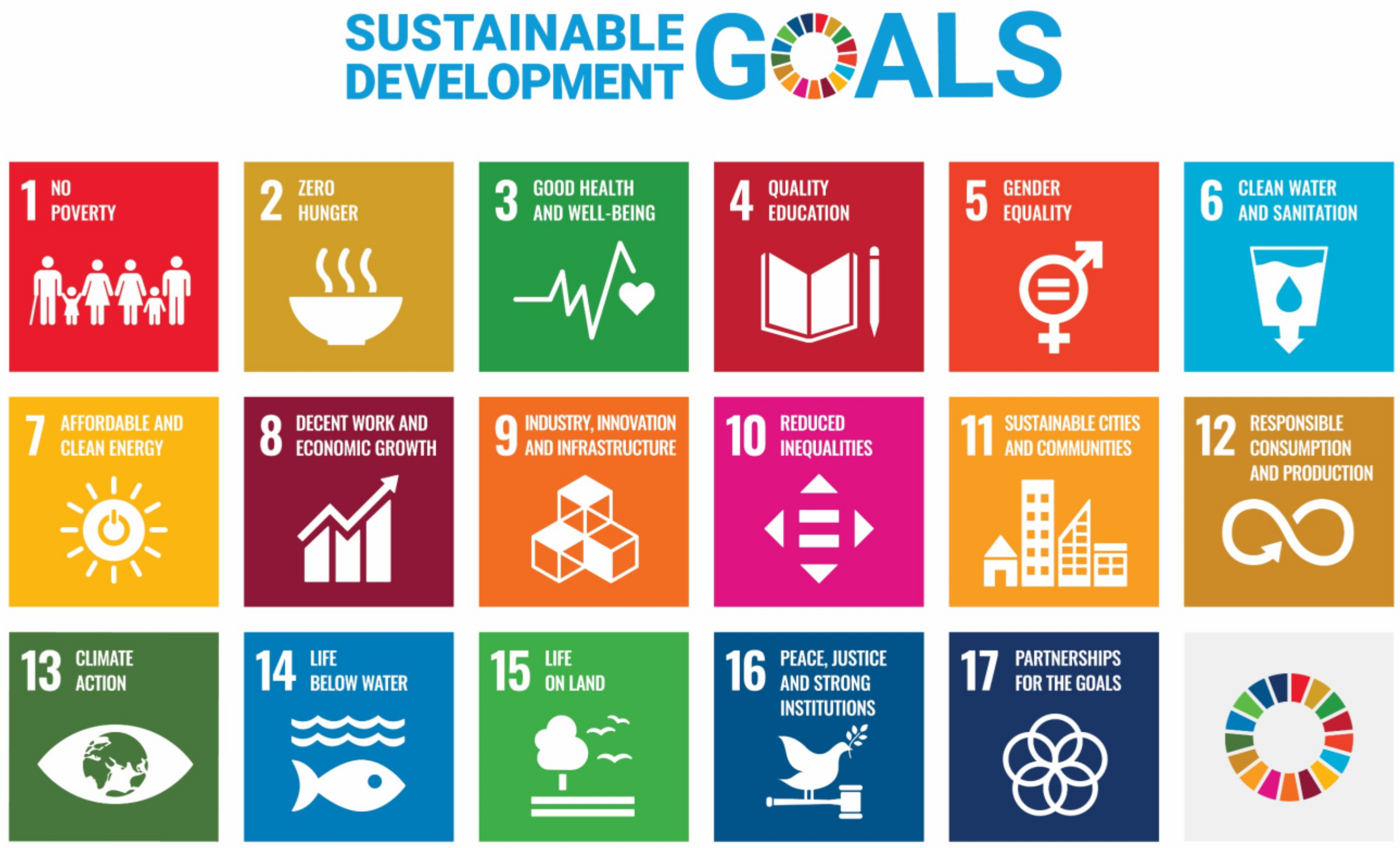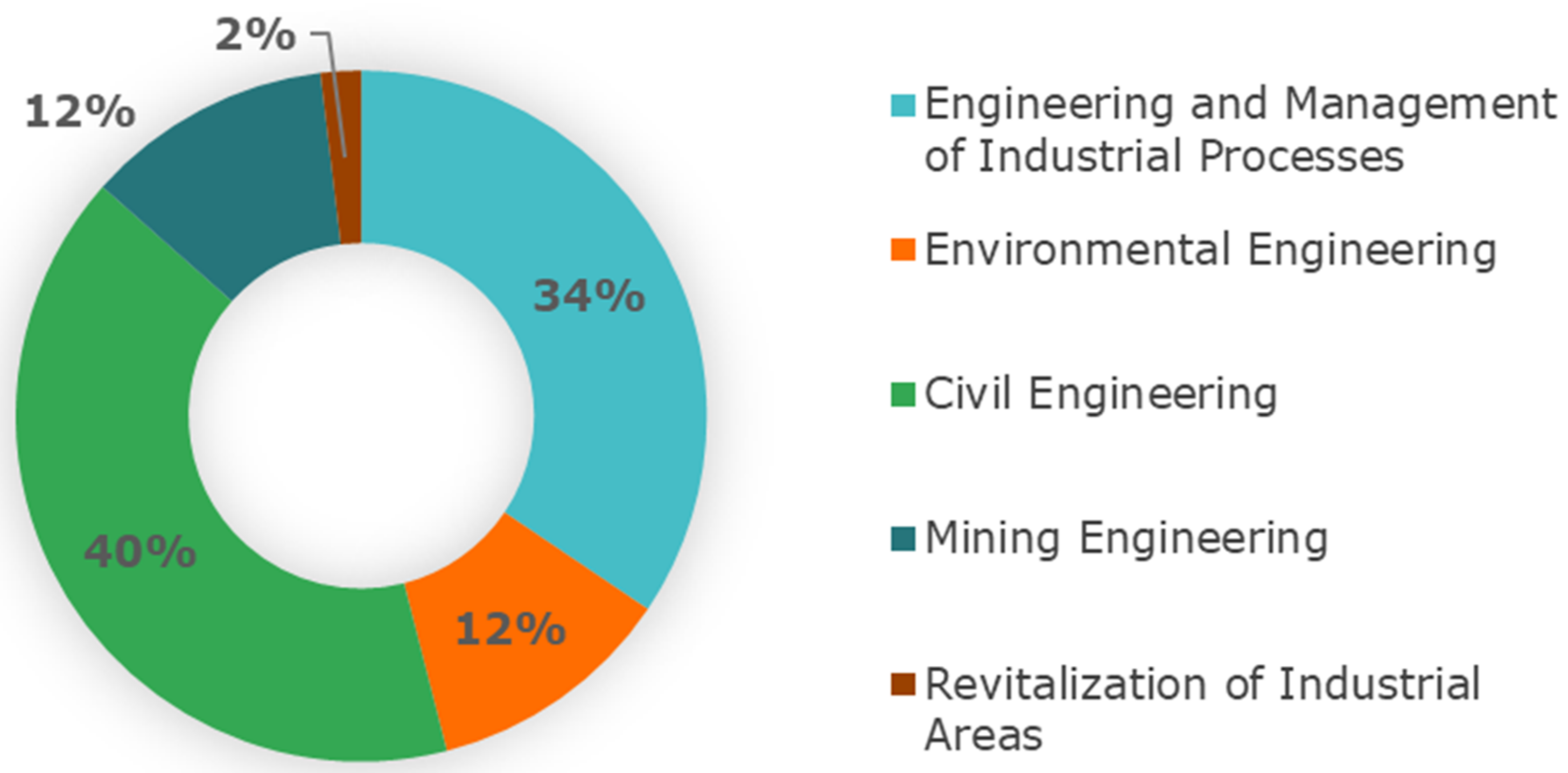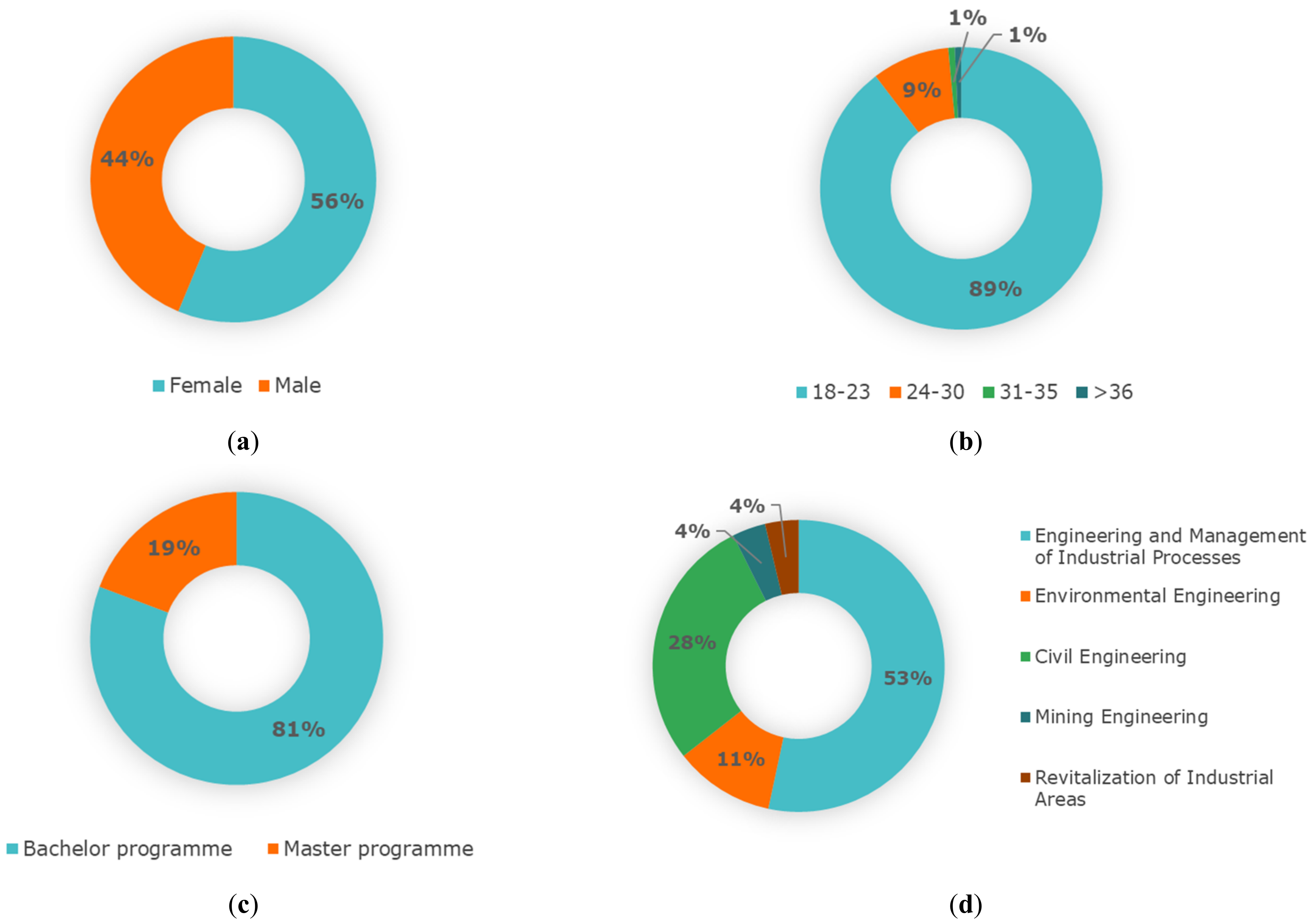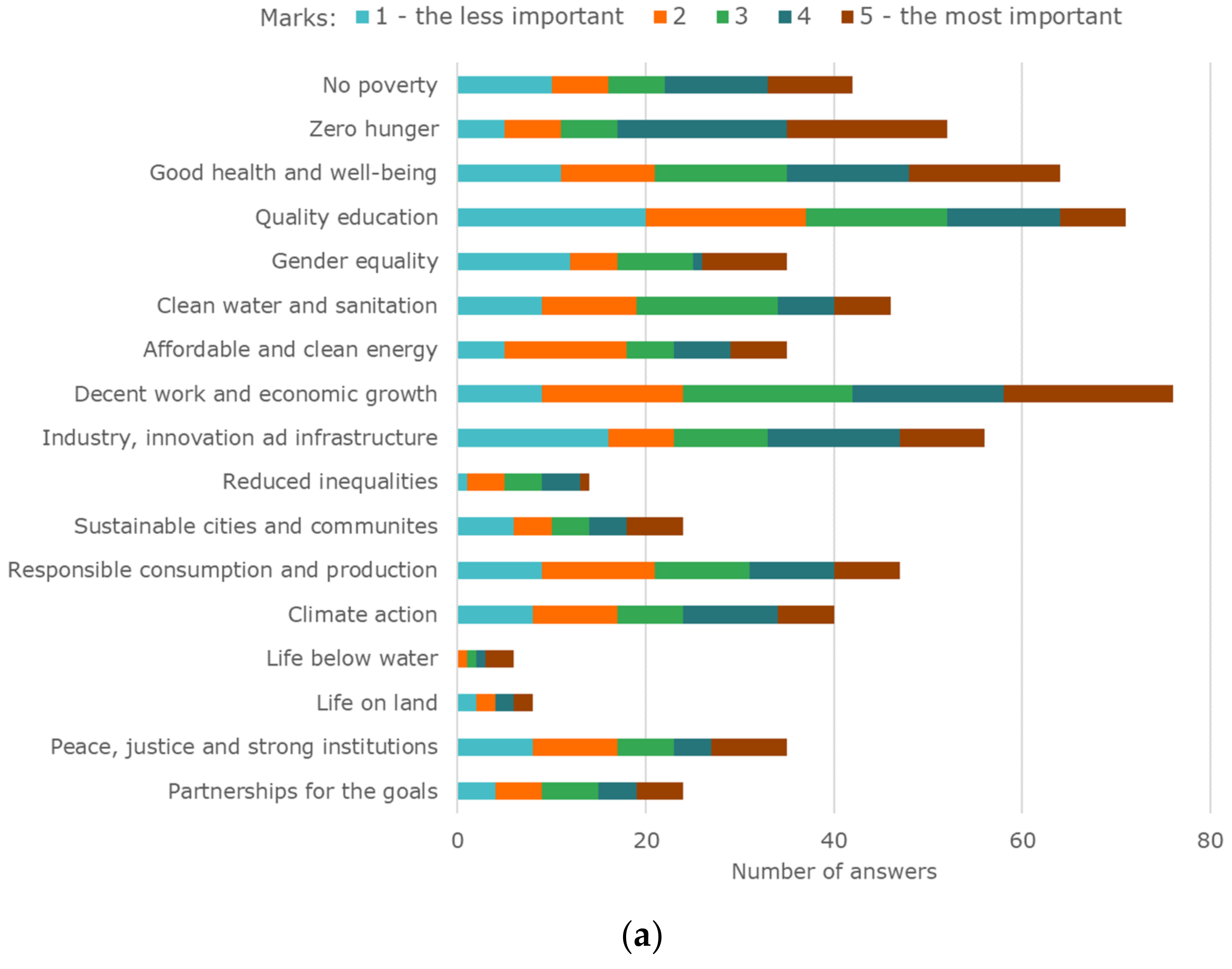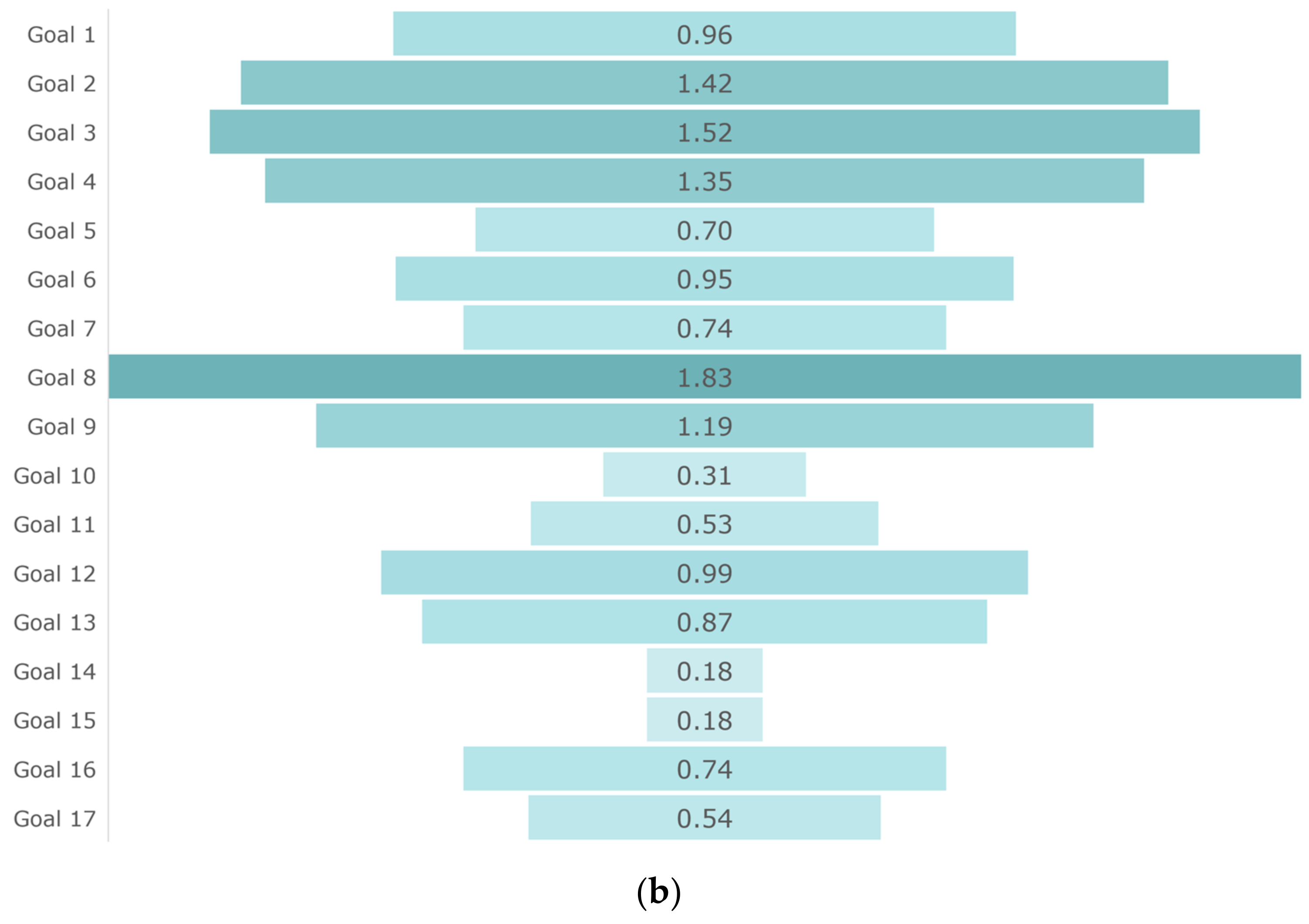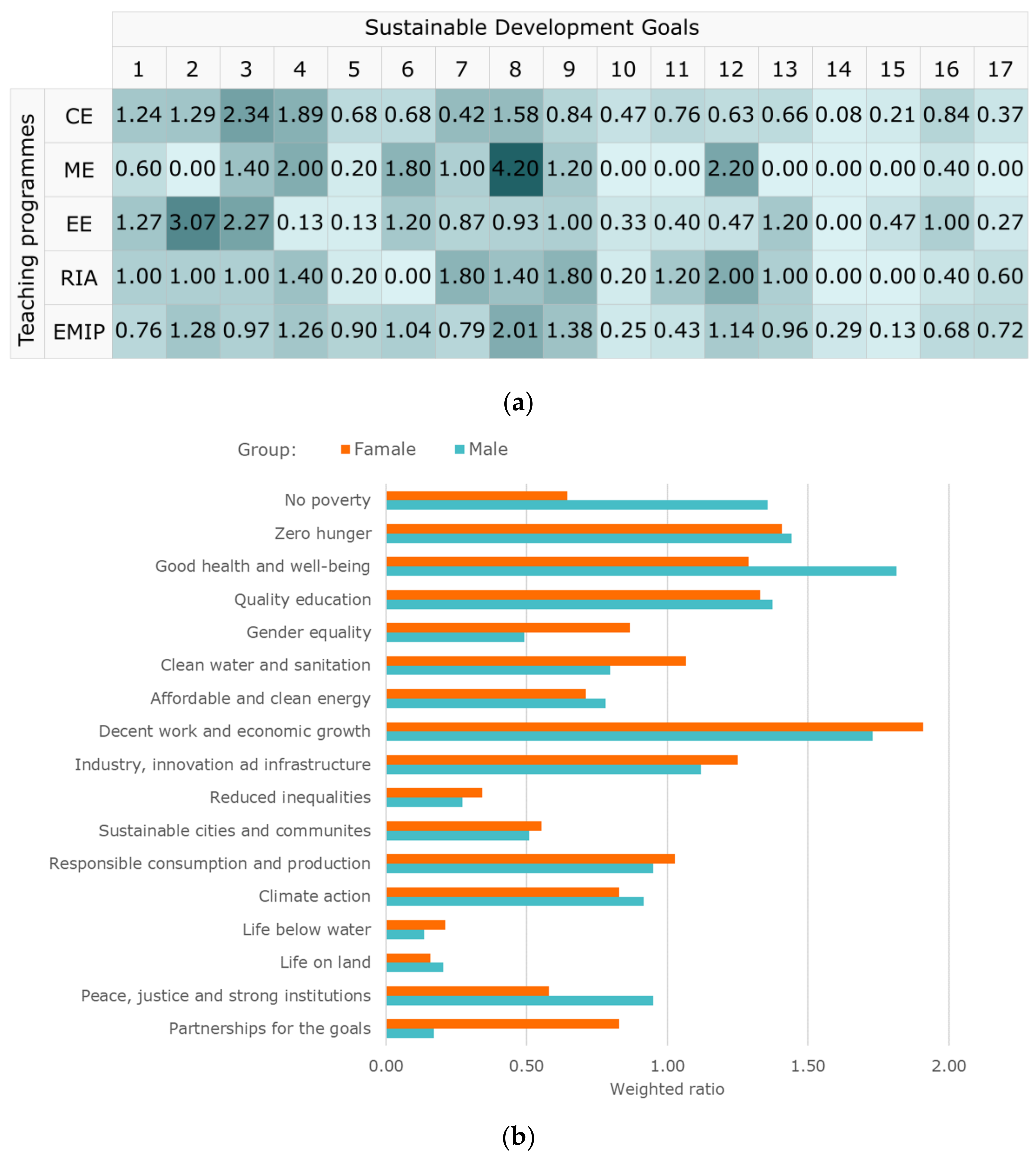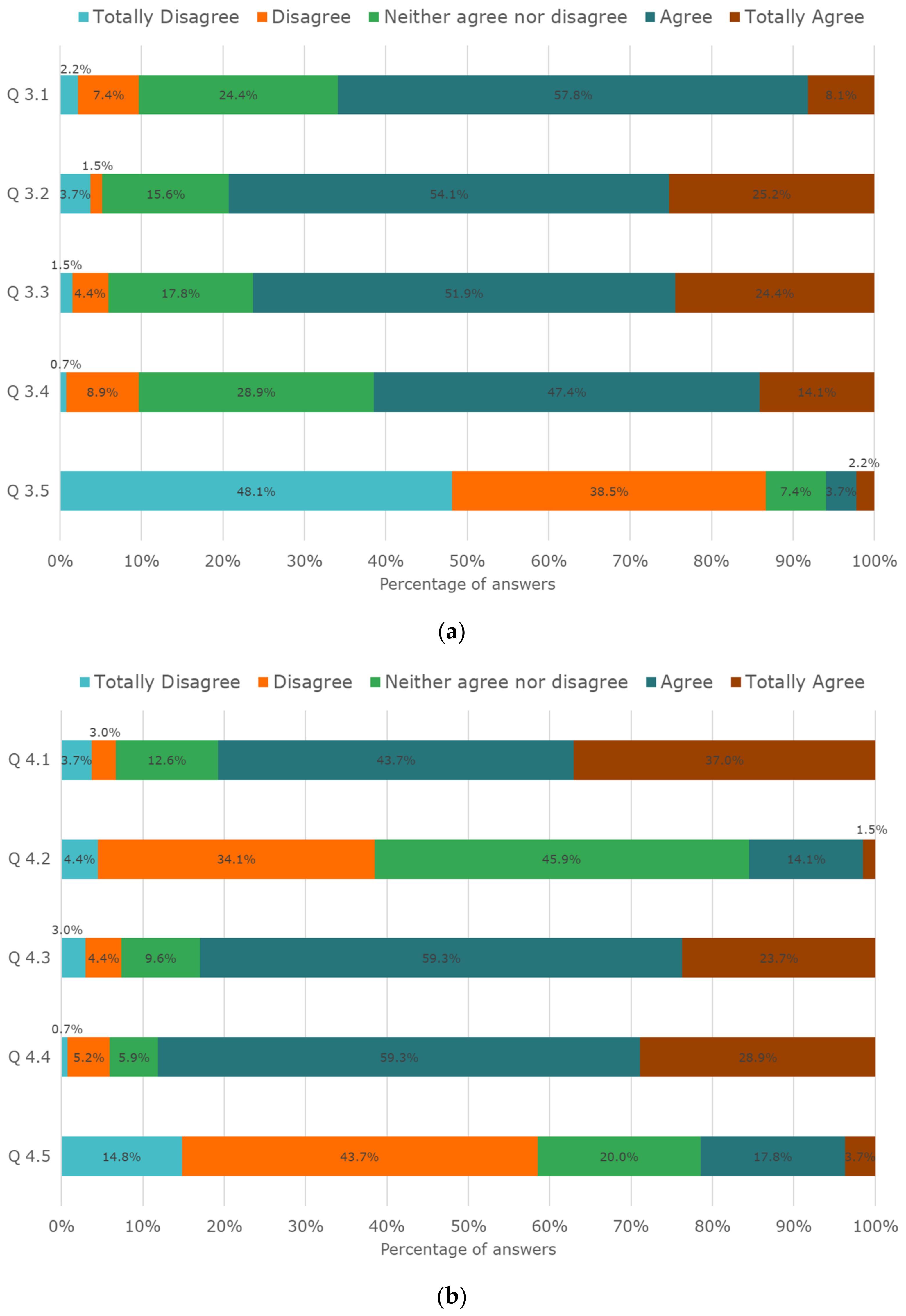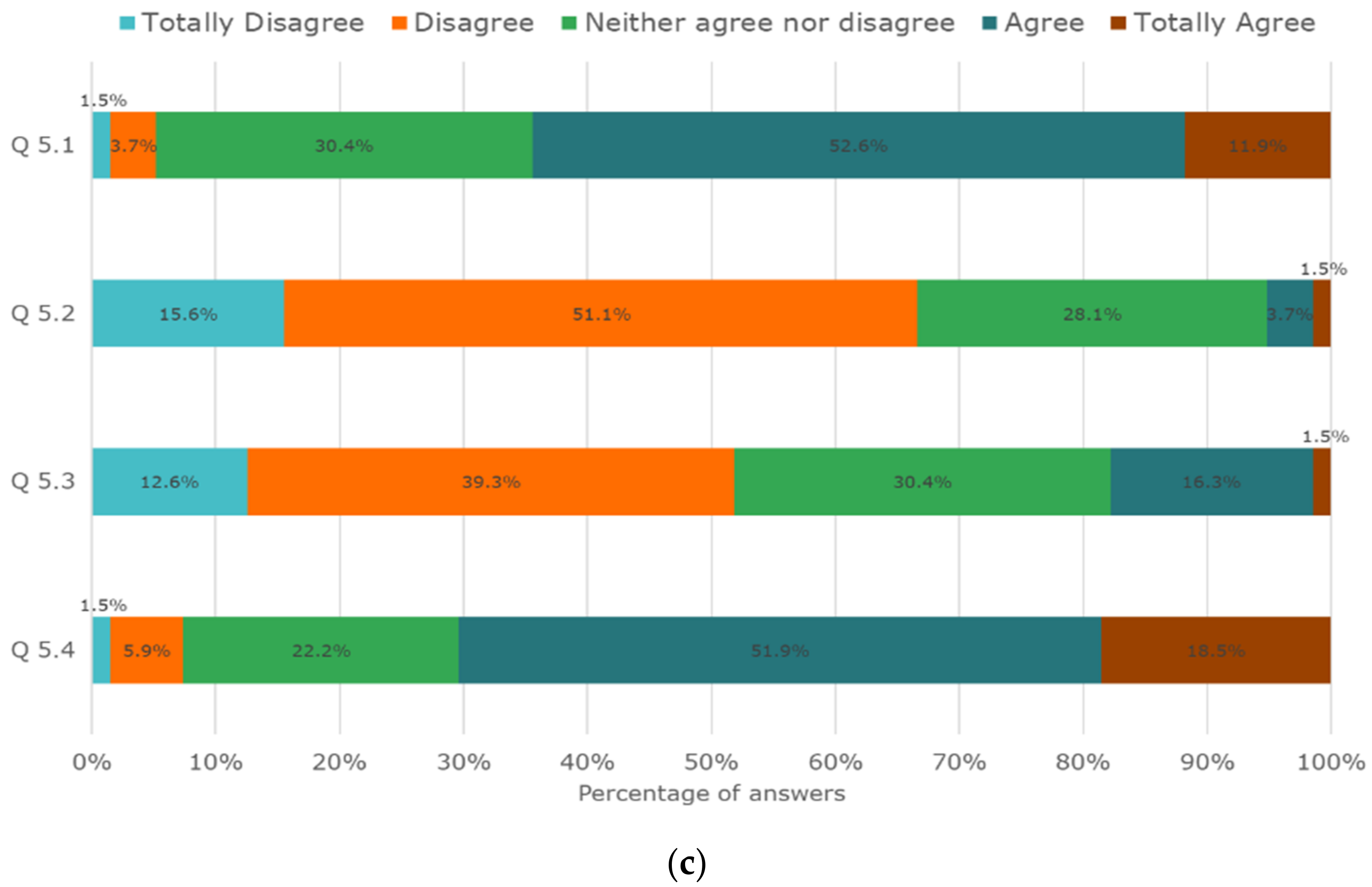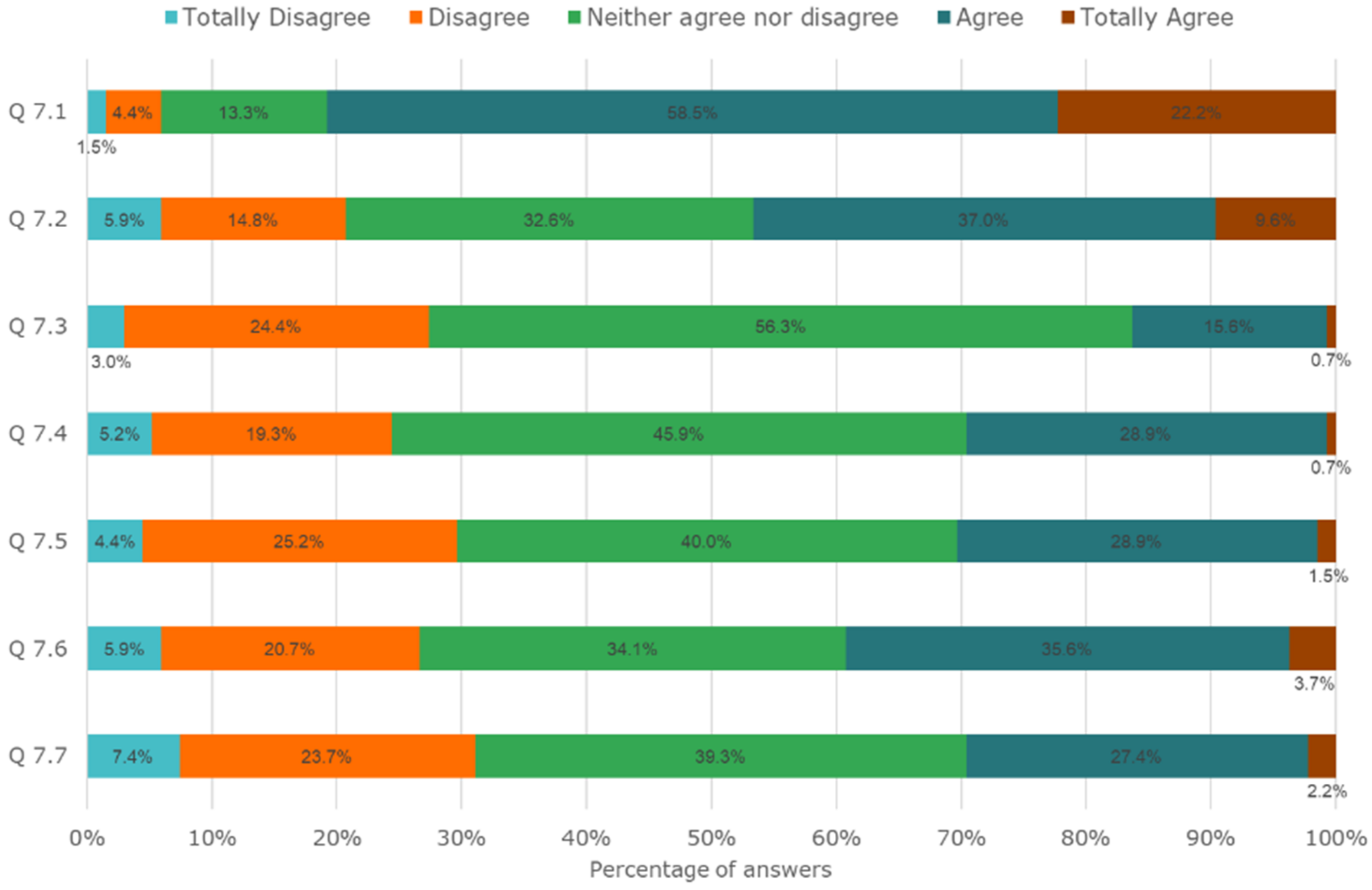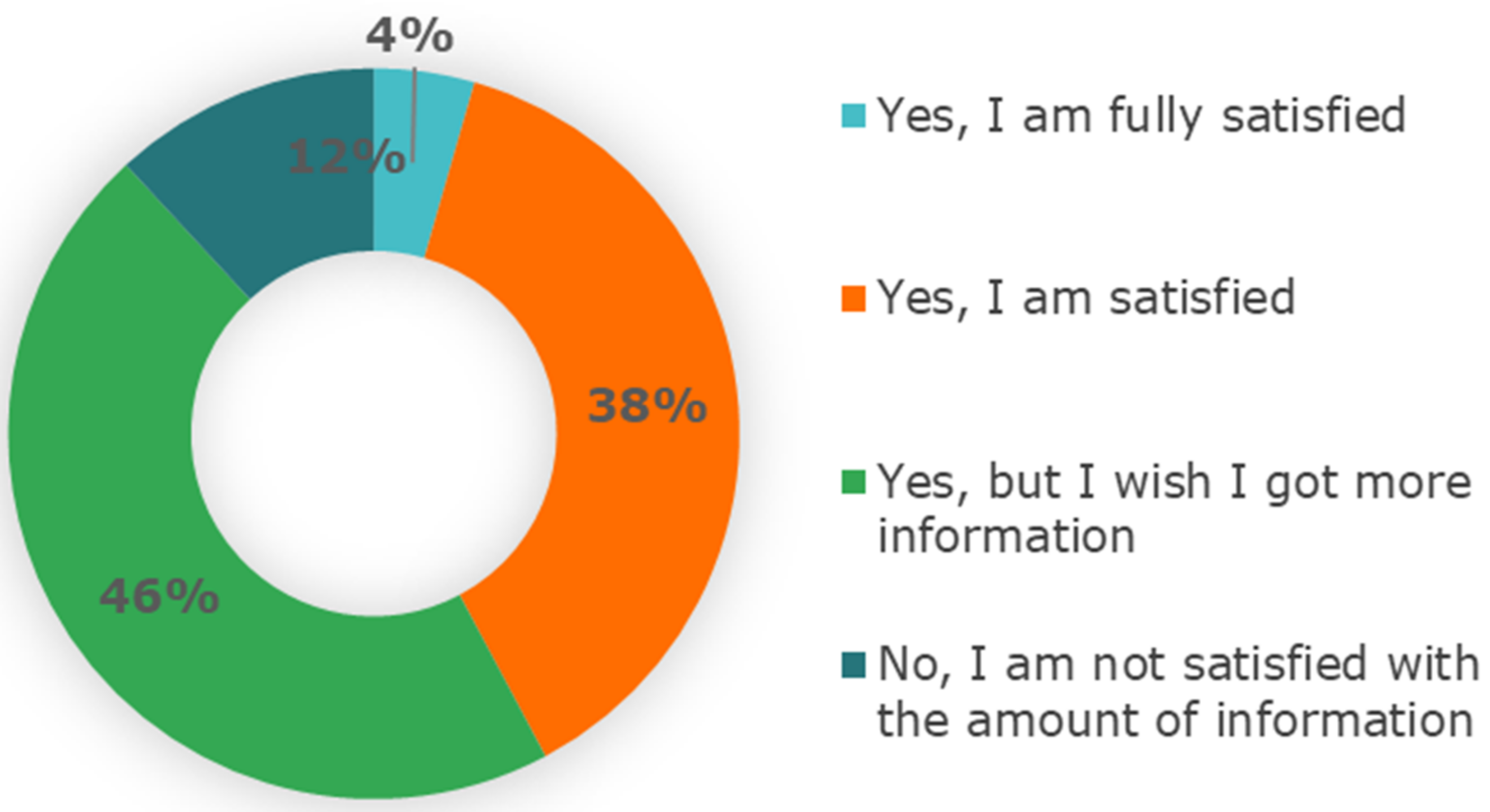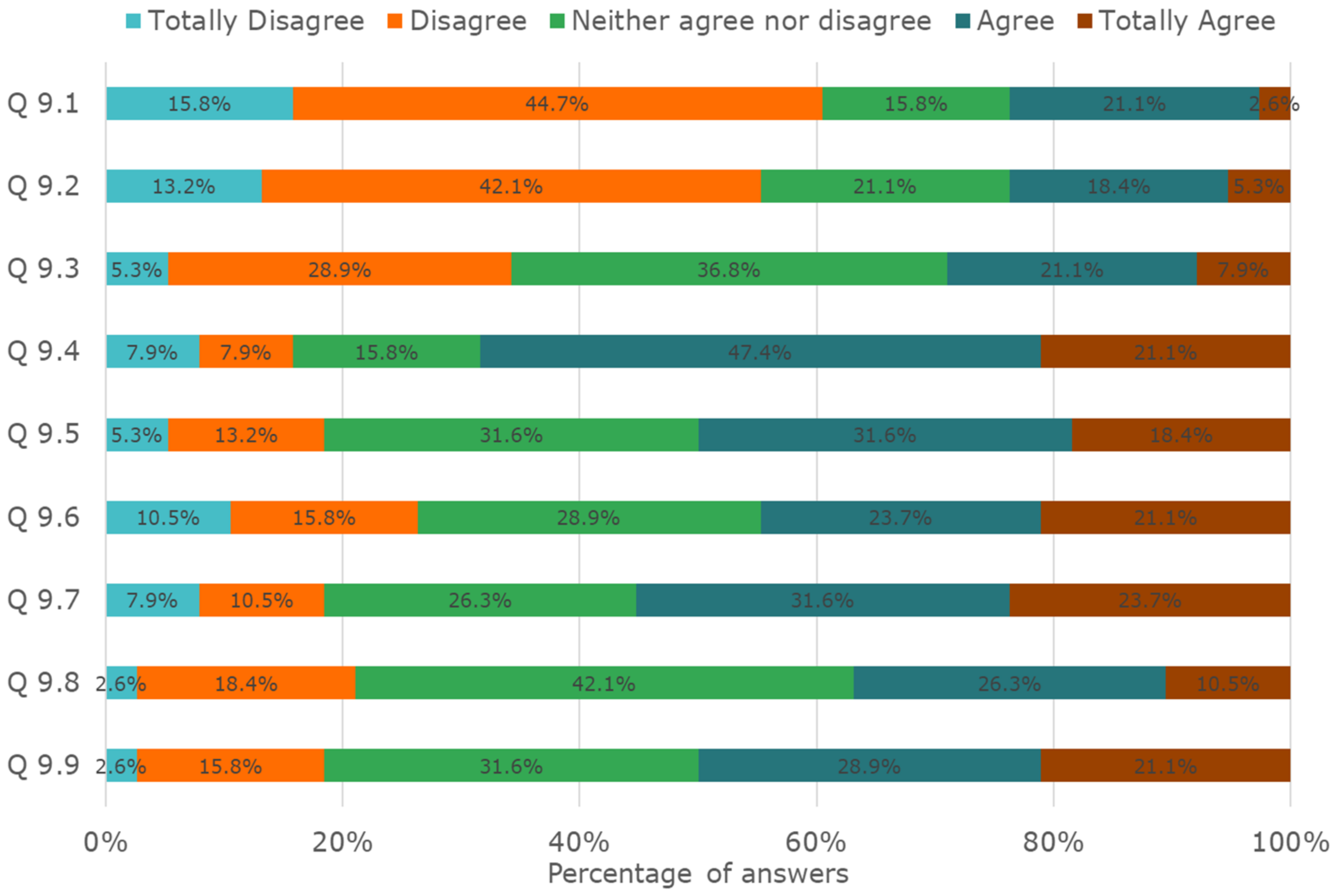1. Introduction
Sustainable development (SD) is one of the most important concepts of the second half of the 20th century. The first attempts to define the idea of sustainable development appeared in a report prepared by the United Nations World Commission for Environment and Development in 1987. It said “humanity has the ability to make development sustainable to ensure that it meets the needs of the present without compromising the ability of future generations to meet their own needs” [
1].
Initially, discussions around sustainable development were limited to the need to reduce the negative impact on the natural environment. Over time, the concept gained a more complete understanding, aligning the essence of the three development factors: respect for the environment, social progress, and economic growth, pointing to the need to move away from the economic dimension in favour of creating value [
2]. Currently, the concept of sustainable development is a key element of the discussion on socioeconomic development, becoming a horizontal principle reflected in all development policies of the European Union.
The practical implementation of sustainable development took place in 2015 when the United Nations (UN) adopted “The 2030 Agenda for Sustainable Development” providing “plan of action for people, planet and prosperity” [
1]. The new vision of development outlined in the Agenda accepted by the international community is to direct world economies onto a sustainable path of development. An integral part of the 2030 Agenda is the 17 Sustainable Development Goals (SDGs) agreed upon by the UN member states, which describe the main development challenges for humanity (
Figure 1) [
3].
The adopted goals (together with 169 tasks and 232 related indicators) transform the endeavour for sustainable development into actions [
4]. Currently, an increasing number of studies indicate the interrelationships and integral nature of the SDGs, representing a systemic approach to sustainable economic development, in which complementarity and compromises in achieving various SD goals are extremely important [
5,
6,
7].
Strategic actions aimed at achieving climate neutrality have also been included in the European Green Deal. The main goals of the strategy, proposed at the end of 2019, are the creation of a modern, resource-efficient, and environmentally friendly economy, as well as a fair and prosperous society [
8]. General assumptions in this respect are guided by the following provisions [
8]:
increasing the EU’s climate ambition for 2030 and 2050,
supplying clean, affordable, and secure energy,
mobilizing industry for a clean and circilar economy,
building and renovating in an energy and resource-efficient way,
accelerating the shift to sustainable and smart mobility,
from ‘Farm to Fork’: designing a fair, healthy and environmentally friendly food system,
preserving and restoring ecosystems and biodiversity,
a zero-pollution ambition for a toxic-free environment.
All of these activities will be reflected in the functioning of Polish entities, especially those of an energy-intensive nature related to the mining and metallurgical industries. The provision relating to stimulating innovation and supporting scientific research (Mobilizing research and fostering innovation) seems to be of particular importance for change and the achievement of set goals. At least 35% of the Horizon Europe budget will be dedicated to financing new climate solutions that are relevant to the implementation of the European Green Deal [
8]. From the educational point of view, the European Green Deal also assumes strengthening cooperation between higher education institutions, research organizations and business, as well as the exchange of good practices based on the creation of new educational modules.
The strategies and Initiatives implemented at various levels are mainly based on the mutual interaction of social, environmental, and managerial factors. This results from the fact that the environment and human needs and activities cannot be viewed separately [
9]. It was on this ground that the concept of education for sustainable development (ESD) was born.
In the face of the current environmental challenges, ESD is one of the most important tools to help bring about positive changes. It is indispensable in shaping mature attitudes of responsible citizenship, and it is also the most important and most effective way of promoting and disseminating the idea of sustainable development among children, youth and society as a whole. While the education system is directly related to SD Goal 4 (ensuring inclusive and equitable high-quality education and promoting lifelong learning to create opportunities for all), the presence of education is indirectly included in all the other Sustainable Development Goals as well [
10].
The education system is a key factor in shifting the conventional development model, focused solely on economic growth, towards a sustainable society. According to the UNESCO report, one of the fundamental conditions for the effective functioning of education in this context is the integration of “the principles, values, and practices of sustainable development into all aspects of education and learning” [
11]. In turn, according to [
12], ESD is something more than a knowledge base related to the environment, economy and society. It includes learning skills, perspectives and values that guide and motivate people to seek sustainable sources of income, participate in a democratic society, and live in a sustainable way. It also includes promoting commitment, instead of just informing; it is the provision of content enabling forward-thinking, problem-solving, joint action, building consensus through dialogue, partnership development or critical and systemic thinking [
11]. Ultimately, it is about ensuring the success of students in their future careers by providing them with the skills, motivations and a set of values that enable them to contribute to the well-being of the global community [
13].
The era of intensive development of the potential of environmental education falls in the 1960s and 1970s, when the phenomenon of environmentalism gained popularity [
14]. The momentum of legislation and activism finally culminated on 22 April 1970, with nationwide education on environmental problems that paved the way for the modern environmental education movement. Internationally, environmental education gained recognition at a UN Conference in Stockholm in 1972, where it was declared that environmental education must be used as a tool to solve global environmental problems [
15]. Its presence on the world stage was additionally emphasized by two subsequent conferences: the International Workshop on Environmental Education in Belgrade in 1975 and the National Conference of Environmental Education Leaders in Washington in 1978. The result of the former is the famous Belgrade Charter, describing the goals of environmental education and provisions indicating the need to include it across all education systems [
16]. The conceptualization of environmental education took place in Tbilisi in 1977, and was the result of the world’s first Intergovernmental Conference on Environmental Education. During this conference, the document now known as the Tbilisi Declaration was adopted, and for many, it remains the final statement of what environmental education is and what it should be [
15]. The significance of environmental education in the perspective of sustainable development was also confirmed by Agenda 21, adopted in Rio de Janeiro in 1992, in which great importance was attributed to the role of social awareness by devoting the entirety of Chapter 36 to education and communication [
2] and the UNESCO Thessaloniki Declaration of 1997. In the latter, education was presented not only as a continuous process aimed at developing the ability to adapt to the rapid changes taking place in the world, but above all as a process of transferring knowledge and information to make society aware of problems and to stimulate that awareness. The Decade of Education for Sustainable Development (ESD), launched in 2005 and published by the United Nations, provided further incentives to implement SD courses in education systems, making education a key factor in sensitizing young people to environmental issues and enabling the desired changes related to human development.
Entries in international documents, published, among others, by UNESCO or the European Union as well as Polish strategic documents, i.e., the State Environmental Policy 2030 or the National Strategy for Environmental Education, indicate the need to implement the horizontal assumptions of education as [
17]:
shaping and strengthening public awareness of economic, social, political, and environmental issues,
enabling every person to acquire knowledge and skills necessary to improve the condition of the environment,
creating new behaviour patterns, shaping attitudes, values and beliefs of individuals, groups and societies, taking into account the concern for the quality of the environment, including the shaping of sustainable consumption patterns.
Higher education institutions play a very important role in the implementation of SDGs [
18,
19,
20,
21]. As emphasized by Veinovic [
22], the achievement of these goals largely depends on the knowledge, value system, skills, and behaviour of each individual (at any age), while sustainable development depends in particular on the involvement of the young generation. Academic institutions can therefore be seen as the drivers of social transformation: they educate future leaders and key professionals, shaping their skills and mentality. As indicated by Sukiennik et al. [
23], higher education undoubtedly makes an important contribution to accelerating the required change through teaching, applied research and cooperation with industry and student organizations. Higher education institutions are now able to extend the teaching of ESD. This is achieved through the active promotion of the ESD mentality, thanks to, among others, running ESD research clubs or establishing partnerships with local businesses and industry, thereby gaining mutual benefit and implementing ESD principles directly at a local and regional level. Educational institutions are centers of value transfer at which future generations will build a sustainable world. It is important that education for sustainable development is an integral part of general education. The same also applies to education in the field of engineering [
24].
The transformation towards an ESD approach requires commitment at all levels of education. It is recommended that the ESD education process starts in primary school and continues all the way through to university studies. However, stakeholders should also include adults and working groups whose activities have a significant impact on the environment. Awareness of environmental challenges is a big step towards changing consumption patterns or citizenship attitudes. However, if the awareness of problems is not supported by the inner need and willingness of individuals, as well as by proper education, it may not produce concrete results and will not solve the existing challenges—thus, the current difficult situation will not change. Research on educational needs in the field of sustainable development is becoming more and more popular, and the Ministry of Climate and Environment undertakes a cyclical survey on the awareness and ecological behaviour of the Polish population. Currently, however, most of the activities aimed at the implementation of the SDGs are carried out at universities. Educational and scientific institutions tend to focus on developing and implementing ESD programmes rather than researching the needs and preferences of different groups of recipients in this field of education. There are also important questions about the methods of increasing young people’s awareness and knowledge about SD. Lozano et al. [
25] focused in particular on appropriate pedagogical approaches that enable the acquisition of competencies for SD. The article analyses competencies and pedagogical approaches using hermeneutics and constant comparative analysis. Teaching methods are proposed within the framework based on the 12 competencies and 12 pedagogical approaches. Among the crucial competencies, the authors mentioned critical thinking, personal involvement, and strategic action. The principal teaching methods include case study, project- and/or problem-based learning, participatory action research, and life-cycle analysis. Many authors have tackled the subject of implementing the SDGs into educational programs and the awareness of students in this regard [
25,
26,
27,
28,
29,
30,
31]. Often, specific universities or few institutions in the selected country are analysed. Stukalo and Lytvyn [
26] analysed the Ukrainian higher education system. The analysis was carried out based on an internet survey and public observations. As the authors noted, the implementation and enforcement of the SDGs should be ensured at the national, institutional, and program levels. One of the recommendations proposed in the article is to treat the achievement of SDGs as strategic goals and a priority in university policy, also reflected in university documents. Alm et al. [
27] have checked the influence of SDGs on motivation of students to learn about sustainable development. On the example of the Swedish university HKR, the authors noted that work-integrated learning, project learning and real-life experiences as part of their studies enhanced the students’ understanding of sustainability. Additionally, understanding the SDGs allows for developing their interpersonal competencies as ambassadors for sustainability in their careers. The knowledge, experience, and expectations of students in the field of SDGs were also the subjects of research by other scientists [
28,
29]. The research conducted by Brzezicki [
28] showed a significant disproportion between the expectations of students and the experience in the field of sustainable and ecological design at the Faculty of Architecture WUST, Poland. The results of the research by Smaniotto et al. [
29] conducted on nine Italian universities showed a significant difference between different groups of students. The authors recommended considering the implementation of academic initiatives to improve the situation. The National University of Kaohsiung in Taiwan is the subject of research by Chang and Lien [
30]. Based on the analysis, problems with the implementation of this topic at the university were noticed. Hence, an attempt was made to promote awareness of SDGs by implementing the SDG course inventory system. The adopted approach of the SDGs course inventory may help to review curriculum structure regularly and allocate resources into their target SDGs. The research conducted on the generational readiness to face the challenges of the current unsustainable development, including [
32,
33], concerns the perspective of young students (early adolescents) as well as teachers and scientists.
This publication is an attempt to present the perspective of the students, their views, assessments, and recommendations in the field of curricula taught at the AGH University of Science and Technology in Krakow (Poland). This work is part of a wider project to promote Sustainable Development Goals in Higher Education Institutions.
2. Project Description and Preliminary Results
For many years, the AGH University of Science and Technology in Krakow (AGH UST) has been carrying out activities and projects aimed at educating graduates with competencies corresponding to the future needs of the economy and the challenges of modern civilization. One of them is the international EnAct-SDGs project, funded by EIT (European Institute of Innovation and Technology), implemented at the Faculty of Civil Engineering and Resource Management, and initiated in 2020.
EnAct-SDG is a two-year integrated RIS (Regional Innovation Scheme) project on increasing the skills of students of fields related to the raw materials sector in ESEE (East and South-East Europe) countries in terms of implementing and achieving the Sustainable Development Goals. The main tasks include developing a dynamic, self-sufficient ecosystem and network between academia, scientists, industry and professionals in the raw materials sector, and to develop an action plan that will stimulate the implementation of objectives such as modernizing educational practices, integrating the principles of sustainable development into the educational programs of ESEE universities, and strengthening the skills and competences of graduates and specialists in the raw materials sector. This project is in line with the strategic objectives of the ESEE RIS of transferring best practices and expertise on Knowledge Triangle Integration (KTI) for actor involvement (KIC) and mobilization, interconnection, and internationalization of national/regional networks, ultimately increasing the impact of the EIT RM community at the European level. The EnAct-SDGs project consortium consists of eight EIT Raw Material Partners: National Technical University of Athens, School of Mining and Metallurgical Engineering—NTUA (Greece, project coordinator), AGH University of Science and Technology—AGH UST (Poland), Technical University of Kosice—TUKE (Slovakia), Montanuniversität Leoben–MUL (Austria), Technische Universität Bergakademie Freiberg—TUBAF (Germany), Università degli Studi di Trento—UniTrento (Italy), Hub Innovazione Trentino–Fondazione—HIT (Italy), and MYTILINEOS S.A. (Greece). Additionally, the project is supported by two RIS Task Partners: Employers’ Organization of Polish Copper (Poland), National Technology Platform for Research, Development and Innovation of Raw Materials (Slovakia) [
34]. The main goal of this project is to build a dynamic network of universities, research institutes and industry and professionals, and to develop a roadmap to modernized education, increasing the capacity of East and South-East Europe (ESEE) university graduates and raw materials (RM) professionals [
34].
One of the elementary project activities was the identification of the educational needs of the RM sector regarding the three partner’s universities. Involving a wide range of stakeholders and examining their perspectives allows for the identification of educational needs and the implementation of proper practices in the educational programmes. Effective activities require the involvement of all stakeholders of the RM sector, including students, academic staff, and industries. For assessment of the three ESEE universities’ curriculums, data were collected at the institute/school/faculty level, as well from the various groups of stakeholders, to acquire an appropriate insight. Preliminary research from partner universities in Eastern and South-East Europe is presented in papers by Pacher et al. [
24] Damigos [
35], and Tomazinakis [
36]. Pacher et al. [
24] assessed and compared curricula of three partners universities that participated in this project. In all study programs, students should complete an average of 30 ECTS per semester or 150 working hours. The authors noticed differences in the integration of sustainability aspects into the courses, including the number of compulsory courses related to sustainability aspects. All universities declared a balanced usage of various teaching methods both within lectures and participatory courses. The authors also compared the number of academic staff and the university-business cooperation. The importance of sustainable development principles for the RM sector is a prerequisite for RM engineers, and it also has a direct impact on student satisfaction. According to the preliminary analyses [
36], in the opinion of the participants, a compulsory course is needed that would provide students with a basic understanding of sustainable development and “horizontal incorporation” of the principles of sustainable development in all technical and non-technical courses. The previous results of the project allow for an overall ranking of the importance of the SDGs in the RM sector of Greece, Poland, and Slovakia. According to the obtained results, the SD’s highest-rated goals by stakeholders are SDG 9 (industry, innovation, and infrastructure), SDG 8 (decent work and economic growth), and SDG 7 (affordable and clean energy). This indicates a strong relationship between these goals and the RM sector. It was also noticed that the goal of SDGs 4—quality education—is significant for particular groups, especially students. This implies a strong need to promote lifelong learning and to integrate sustainable development topics into curricula. According to the preliminary results, all the stakeholders of the project shared the view that it is quite important to integrate sustainability thinking into the RM engineering curricula. Furthermore, it should be considered a priority in the educational process.
As part of the EnAct-SDGs project, the study structure and curricula at the Faculty of Civil Engineering and Resource Management were analysed to assess the incorporation of the principles of sustainable development into study programs based on selected criteria. Based on the interview with a focus group contained with Polish stakeholder representatives from industry, a mining association, and academia, general observations were noticed. All the focus group participants agreed that integrating the concept of SD with the traditional curriculum of RM faculties should be considered a priority in the area of development and improvement of educational processes. Awareness and understanding of the principles of SD, the impact of all mining activities on future generations, and their “well-being” in economic, social, and environmental aspects forms the basis of the knowledge base and education of the future RM engineers. Practically all participants agreed that including the SD topics in as many courses as possible in the curricula is the right thing to do. This topic should be part of other subjects, because mining and industrial processes will not be considered in isolation from the environment, innovation, economic development, and social issues. However, it was also noted that there should be a separate course that would introduce the role of SD, the basics of the SDGs, and an indicator system that checks the performance of SD goals. All the participants noticed that the development of soft skills is fundamentally important. Among mentioned skills and abilities were teamwork, effective communication, and the ability to conduct joint activities. As many of the participants mentioned, however, existing RM curricula focus mainly on hard (engineering) skills, and soft skills are often ridiculed because they are non-engineering, immeasurable skills. The stakeholders noted that having the ability to work in multidisciplinary teams is important in the context of implementing SDGs. SD is by definition a multidisciplinary activity, which is based on the cooperation and integrity of various branches and ventures. Thus, working in multidisciplinary teams could be very beneficial for students.
The results presented in the article are part of the stage of the above-mentioned identification of areas that require improvement at the university. The research included an analysis of conditions at three universities. Nevertheless, this article focuses on the results concerning only AGH University of Science and Technology. Student engagement is crucial for achieving sustainable changes in the curriculum. Students should be aware of the benefits of education for sustainable development.
3. Materials and Methods
3.1. Data Collection and Respondents
The research was conducted on students of the Faculty of Civil Engineering and Resource Management (old name Faculty of Mining and Geoengineering) in the academic year 2020/2021. The faculty offers five study programs in various disciplines and areas of interest. The faculty’s offer includes Engineering and Management of Industrial Processes (EMIP), Environmental Engineering (EE), Civil Engineering (CE), Mining Engineering (ME) and Revitalization of Industrial Areas (RIA). In 2020, 1745 students studied at the faculty, of which 1384 were full-time. Within the framework of the currently run curricula at the faculty, separate subjects (of obligatory and optional character) concerning SDGs are currently implemented (e.g., Fundamentals of Engineering and Environmental Protection, Air Protection, Waste Management, Cleaner Production-Environmental Management, Environmental Impact Assessment, Sustainable Development in Production Processes).
Figure 2 shows the structure of the faculty by students attending various fields of study.
The questionnaires were distributed among students by e-mail. The responses were collected using the Google Forms tool. Participation was anonymous, voluntary and based on informed consent. This means that the survey was not part of a formal student assessment, and the students were invited via university mail to take part in the survey. The students were informed about the right not to answer the questionnaire. A survey was completed by a total of 135 students attending five fields of study at the Faculty of Civil Engineering and Resource Management. To provide the statistical validity of the data, the sample size had to reflect the overall population. Based on the assumed confidence level and maximum margin of error, the required sample size was calculated. The size of the population was 1384, i.e., the number of full-time students at the faculty in 2020. The margin of error coefficient was assumed at the level of 8%, analogous to the values adopted by the authors in other publications relating to the results of survey research [
38,
39]. Depending on the study, the confidence level usually amounts between 90% and 99%. The sample size was calculated using a margin of error of 8% and a confidence level of 95%, and amounted to 135 samples. The sample size analysed in the article consisted of 135 students, which was found as a satisfactory and representative probe.
3.2. Research Questions and Objectives
Implementing SDGs into the curricula aims to meet the growing environmental challenges facing civilization. Education must change to provide the knowledge, skills, and attitudes that enable learners to contribute to sustainable development. Traditional knowledge delivery is no longer sufficient to inspire learners to act as responsible citizens. In research, the students’ approach to sustainable development was analysed. The main aim of the survey was to check the students’ knowledge about sustainable development and to find out their opinion on implementing SDGs into the curriculum. The conducted research had two general objectives. The first general objective (GO1) is to test and assess the attitudes and level of environmental awareness of students in the field of sustainable development. Additionally, the second aim (GO2) is to analyse the need for curriculum changes. For this purpose, three research questions were formulated, as below:
RQ1. Are students familiar with the concept of sustainable development?
RQ2. Do students understand the need to implement SDGs?
RQ3. Is the knowledge of sustainability development taught in the curriculum deemed sufficient?
As mentioned in chapter 2, the conducted surveys were one of the activities that provided an in-depth analysis of the project’s stakeholders’ opinions. Based on the preliminary analysis of the collected data, the opinions of key interest, and considering research objectives, the following hypotheses were formulated:
Hypothesis 1 (H1). Assessment of the sustainable development goals and the selection of the most important SDGs are affected by personal characteristics, including gender and field of study.
Hypothesis 2 (H2). Students know and understand sustainable development goals.
Hypothesis 3 (H3). Students notice the importance of sustainable development, both for education, industry and personally for the student.
Hypothesis 4 (H4). Students would like to gain more knowledge about sustainable development within the curriculum.
Hypothesis 5 (H5). Students are not fully satisfied with the level of SD implementation in their curriculum.
The survey was divided into 4 thematic sections. The introductory chapter marked with the number 1 concerns the personal information and experience of students, including scientific publications and events in the field of sustainable development, as well as internships and apprenticeships undertaken during their studies. The second section of questions dealt with the students’ general comments and perceptions on sustainable development. The third dealt with the issue of the evaluation of the curriculum. Finally, the questions in chapter 4 concerned students’ feelings after completing internships or apprenticeships. The research design is based on the priority action areas established by the Global Action Programme on ESD [
40]. The research survey mainly regards SD awareness, the benefits of internships, and the assessment of curriculum structure and content according to SD principles. The questions proposed in the article have been prepared based on a questionnaire developed under the EnAct-SDGs project. The first part includes seven questions concerning personal information on the participants, such as gender, age, study programme, the field of study, study year, and their employment situation during their studies. The next four questions in this section refer to the respondents’ experiences with SD. These questions include published articles, participation in conferences, seminars, and internships. The second part of the survey concerns the opinions of students about SD. The developed statements have been based on the studies of Lanziner and Strong [
41] and McCormick et al. [
42]. The third part includes three questions that examine the opinions of students about their knowledge, skills, personal development, and pedagogical approaches used in their curriculum. In question 7, a total of seven statements were defined based on the study by Sivapalan et al. [
43]. One question in the last section consists of nine statements and is addressed only to students who have to carry out an internship as part of their university studies. Most of the posed statements have been adopted, after modification, from the study by Pike [
44], and survey students’ views on work experience [
45]. Proposed phrases refer to student perceptions of the use of their knowledge during internships and student satisfaction with different aspects of their work experience.
The survey consisted of closed-end questions, where, when asked about more complex issues, the respondents had the opportunity to enter their thoughts in a comments field. In the first question of the substantive part concerning the significance of the sustainable development goals, the respondents were asked to select the five most important goals in their opinion and to weigh them according to significance on a scale from 1 to 5, where 5 was for areas with the highest and 1 with the lowest significance. During the analysis of the results of this question, a weighted average was used, where the weights were scores from 1 to 5 and the areas that were not selected received a score of 0. In this way, the average scores for each of the sustainable development goals were determined. For this question, the analysis also included the results for individual groups, where the division was made based on professional activity and field of study.
Most of the questions used the Likert scale, thanks to which it was possible to assess the degree of acceptance of certain statements. For the purposes of the research, a five-point Likert scale was selected for statements arranged in order from total rejection to complete acceptance, as shown in
Table 1. The respondents choose the statement that best suits their feelings.
Table 2 presents the questions that were included in the survey, taking into account the possible answers available to the recipients.
3.3. Data Analysis
Initially, data were checked during entering responses to the calculation sheets. Then, a preliminary analysis was performed. The analysis of survey responses began with personal and experience-related questions. In this way, the representativeness of the group included in the study was also checked. The first step of the data analysis covers the structure of the sampling group. The selected personal data were presented graphically and in the table. There are three types of questions in the correct part of the questionnaire (Parts 2–4). Question Q2 requires the selection of the five most important SDGs and their assessment on a scale of 1–5. The results are presented in the form of a bar graph showing the assigned scores. In this question, a weighted average of the scores assigned to subsequent SDGs was used to properly visualize the results. The weighted average ratings for each of the goals were calculated according to the respondents’ scores. It was assumed that not selecting a specific goal means assigning a rating of 0. Then, the analysis of weighted averages of grades, including the group structure, was provided. The results were presented depending on the gender and field of study of the respondents. Most of the questions use the Likert scale, and the results obtained in this way are presented in a bar chart, which shows the percentage share of grades for each question separately. The exception is question Q6, for which the results are presented in the form of a pie chart due to graphical readability. Question Q8, on the other hand, is a single-choice question, and the results are also presented in the form of a pie chart.
5. Discussion
The main purpose of this article is to test students’ views on sustainability and their approach to implementing SDGs in their curricula. For this purpose, a questionnaire was prepared to probe their experiences, knowledge, and proposed changes. A survey is a method very often used to find out students’ opinions on current curricula and to introduce possible changes in their scope. In the literature, one can find many studies on this subject, including studies on the introduction of knowledge on sustainable development [
46,
47,
48]. More and more universities are deciding to analyse the needs of students and their knowledge of SD [
20,
21,
23]. Analysis of the answers was necessary in order to define the current state, needs, and educational challenges faced by the faculties in relation to the implementation of the principles of sustainable development within their educational programs.
Students identified “Decent work and economic growth” as the most important of the sustainability goals. This demonstrates an economic approach and students’ awareness of the key importance of sustainable development in terms of economic growth. This objective was rated highest by Mining Engineering and Engineering and Management of Industrial Processes students. Environmental Engineering and Civil Engineering students definitely valued the SDGs related to aspects of human health and life more highly, among them “Zero hunger”, “Good health and well-being”, and “Quality education”. The analysis of the results shows that there is not enough emphasis on soft skills and decision-making techniques, which need to be developed compared to theoretical knowledge. Students perceive the relevance of the SDGs and see the need to develop knowledge in this area, but often cannot translate it to their discipline or to real-world applications.
Regarding research hypotheses, the results presented in
Figure 5 show apparent differences between the assessments of particular groups. It confirms Hypothesis H1 regarding the impact of gender and field of study on the evaluation of the importance of SDGs. Hypothesis H2 was partially confirmed in question Q3.1, which regards acquaintance with the SDGs. A large majority answered in the affirmative, and only less than 10% disagreed with this statement. Partly, question 3.5 also supports this hypothesis. Students were asked if environmental hazards were not their concern, and the vast majority (86.6%) did not agree, which shows that students are environmentally aware. These results also support Hypothesis H3. The entire of
Figure 6 shows the students’ awareness of the need to implement SDGs at different levels of life. The results support Hypothesis H3 that students notice the importance of sustainable development at various levels. Hypothesis H4 is mainly confirmed by the results of questions 7.1 and 7.2 presented in
Figure 8. The vast majority of students (80.7%) agreed that the SD principles should be emphasized, and 46.6% of respondents would like to actively include and promote SDGs in all fields of their studies. Hypothesis H5, regarding satisfaction of students the level of SD implementation in their curriculum, is mainly supported by results presented in
Figure 9. More than half of the respondents indicated that they wanted more information on this matter during their studies. Universities, as part of a global academic community with shared values, should engage with the global challenges of today [
49,
50]. These institutions play a key role in shaping the worldview and knowledge of the younger generation [
51,
52]. The specific topics that should be addressed at this stage of education are therefore issues related to solving global problems and challenges, which is directly related to sustainable development [
52,
53]. Often, the current curricula are not adapted to the challenges of today [
22,
48]. Universities are therefore faced with a huge challenge of transforming and supplementing the current curricula with the content that is most relevant today. As mentioned above, the main aim of the article and the analysis carried out was to check the students’ opinions on the inclusion of the subject of sustainable development. The basic question the authors wanted to answer was whether it is necessary to include the SDGs in curricula, and if so, how to do it, and what methods and tools to use for this purpose. A two-way approach to this issue is possible.
The SDGs can be integrated into existing courses and curricula, or new programs can be created with a direct focus on sustainability [
37,
52,
54]. Education about sustainable development can be organized in a number of complementary ways. Among these are the inclusion of sustainability objectives both in the learning outcomes of individual courses [
22] and in the scope of directional examinations of individual curricula. Moreover, it would be good practice to start optional or obligatory courses in basic knowledge of sustainable development [
55]. As the results of the questionnaires show, it is also crucial to adapt teaching methods and techniques, both to the conveyed contents and to the latest trends in teaching [
56,
57,
58,
59,
60,
61]. This will increase the effectiveness of teaching. Such methods include problem-based learning, experiential learning, active learning, group work, etc. [
62,
63,
64]. A key and very promising conclusion that can be drawn from the above analysis is that students are highly aware of the importance of sustainable development. It is worth noting that all proposed solutions must not reduce the emphasis on basic content, including the theoretical and technical knowledge of students. The biggest challenge of implementing the SDGs in curricula is therefore to increase the emphasis on this topic while avoiding a negative impact on engineering skills needed in the profession.
Within the project, four focus areas were indicated, i.e., University–Business Cooperation, Content of Curriculum, Teaching/Learning Methods, and SD Awareness. Based on all conducted studies, activities needed to increase students’ SDGs knowledge and skills were identified. In the area of Content of Curriculum, the proposed activities include industry meetings with students, modernization of the courses, industry participation on content, new education tools, incorporating SDGs in most subjects, and new courses related to SDGs. The teaching/learning method also directly influences the content taught. The key proposals include such activities as working on case studies/real-life examples, group work, soft-skill training, idea development, and learning the meaning of SDGs. Of course, the development of new teaching methods, including creative thinking exercises and debates, is also crucial. The proposed activities perfectly match the results obtained in the survey. Attention can be paid to soft skills and decision-making abilities that could be strengthened thanks to the activities mentioned above, such as the use of new teaching techniques. Students are aware of the need to implement SDGs, and expressed their need to expand their knowledge of this topic. Therefore, the modernization of education programs is necessary. This could include both modifications of the existing courses and a proposition of new ones related to SDGs.
The first stage of the implementation of SDGs training for the students was the organization of the three pilot schools. The best education practices were transferred from the innovation providers to the beneficiary universities. The main task was focused on innovation, market situation, the circular economy, and its impact on the environment and society. During the pilot schools, students were trained and mentored in problem-solving education based on real challenges provided by the industry. The participants worked with an industry representative, who provided challenges and mentoring to the students. The students worked in small teams and dealt with real problems faced by the industry. The students were satisfied with both the form and the knowledge gained during the workshops. Among the main positives, they mentioned improving their ability to work in multidisciplinary teams, out-of-the-box creative thinking skills, and practical skills in problem-solving.
The authors see the necessity to continue this research and expand its scope. As the project intends to continue raising young people’s awareness of the SDGs, the authors plan to conduct further research in this area and compare it in a dynamic analysis with the results shown in this publication. As the results show, in many questions, there were significant discrepancies between the responses. The most advantageous solution could be the introduction of periodic, compulsory surveys for graduates in order to react quickly to the necessity of introducing changes. With the knowledge about the needs of students and their feelings about the currently implemented curriculum, it would be possible to optimize the scope of each field of study. From a logistics point of view, the faculty already has an IT system for the exchange of information with students where such surveys could be conducted for this purpose.
The main limitation of the analyses is the fact that the research sample came from only one faculty of the AGH University of Science and Technology. This means that the results cannot be generalized to the entire AGH UST student community, let alone Polish students in general. It is important, however, that the analysis took into account the dependencies on the field of study studied. Moreover, non-probabilistic selection methods based on a convenient selection of the sample were used, which has an impact on drawing general conclusions. The resulting limitations could be reduced by making the questionnaires available to students from other Polish universities to confirm or challenge the assessments presented here.
6. Conclusions
The article presents the results of a survey conducted among students of the Faculty of Civil Engineering and Resource Management at the AGH University of Science and Technology. The research was carried out as part of the EnAct-SDGs project, funded by EIT RawMaterials. The main goal of the project is to build a dynamic network of universities, research institutes, industry leaders and specialists, and to develop a roadmap for modernized education, empowering Eastern and South-Eastern European University (ESEE) graduates and raw materials (RM) specialists. The surveys emphasized the importance of skills such as creativity, critical thinking and decision-making techniques. The results show that students are aware of the importance of sustainable development in various aspects of life, including at the stages of education, work, and life, as being part of a conscious society.
The analyses show that the majority of the faculty students claim to be aware of the Sustainable Development Goals and increasingly feel a shared responsibility for the implementation of comprehensive actions in SD areas. However, a feeling was observed among the research group that the information they received through various channels, including university teaching, was insufficient. After conducting various contrasts of the hypotheses, significant differences were found only for the field of study and gender.
Significant differences in responses were identified between students of Mining Engineering, Engineering and Management of Industrial Processes, versus Environmental Engineering and Civil Engineering. In the case of Revitalization of Industrial Areas, due to the low number of questionnaires of this faculty, it is very difficult to evaluate the results, and the ratings of the individual SDG are close to each other. The surveys showed that the need to develop both specific and transversal competencies is more than justified. It is suggested to focus on developing creativity and innovation competencies among students and strengthening cooperation in multidisciplinary teams. It also seems important to create awareness in terms of future challenges in the raw materials industry related to digital transformation or difficult conditions for mining.
Previous methods of increasing students’ knowledge and awareness of SD have consisted of indirectly emphasising its relevance when discussing issues in other subjects. The experience of other universities indicates that such a method is successful, but that it is more effective to integrate and emphasise content directly related to SD more strongly [
25,
27,
30]. Activities to improve curricula must follow an iterative process in order to respond to the teaching needs of students on an ongoing basis. According to the authors, the best way to develop these competencies is to implement the SDGs in a variety of courses, both core and specialist, allowing cross-curricular development in all subjects.
The authors believe that increasing the awareness and knowledge of the young generation regarding social, environmental, and economic issues is the responsibility of higher education institutions. Only continuous education on socially responsible attitudes is an effective way to quickly and efficiently implement the idea of sustainable development in the national and global economy. Moreover, only appropriately selected objectives, scope and didactic methods will allow for preparing students for their future careers. This paper may contribute to a better assessment of future initiatives in planning the teaching process.
